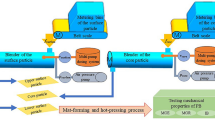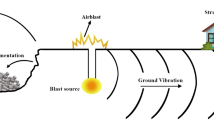Abstract
The production process of ground granulated blast furnace slag (GGBS) aims to produce products of the best grade and the highest yields. However, grade and yields are two competing objectives which can not be optimized at the same time by one single solution. Meanwhile, the production process is a multivariable strong coupling complicated nonlinear system. It is hard to establish the accurate mechanism model of this system. Considering above problems, we formulate the GGBS production process as an multiobjective optimization problem, introduce a least square support vector machine method based on particle swarm optimization to build the data-based system model and solve the corresponding multiobjective optimization problem by several multiobjective optimization evolutionary algorithms. Simulation example is presented to illustrate the performance of the presented multiobjective optimization scheme in GGBS production process.









Similar content being viewed by others
References
Branke E, Deb K, Dierolf H, Osswald M (2004) Finding knees in multi-objective optimization. In: International conference on parallel problem solving from nature, pp 722–731
Chen Y (2008) Study on separator of large-scale vertical mill. Dissertation, Chongqing University
Chithra D, Nazeer M (2012) Strength and chloride permeability studies on ground granulated blast furnace slag admixed medium strength concrete. In: 2012 international conference on green technologies (ICGT), pp 103–106
Coello CAC, Van Veldhuizen DA, Lamont GB (2002) Evolutionary algorithms for solving multi-objective problems. Kluwer Academic, New York
Deb K, Pratap A, Agarwal S, Meyarivan T (2002) A fast and elitist multiobjective genetic algorithm: NSGA-II. IEEE Trans Evol Comput 6(2):182–197. doi:10.1109/4235.996017
Grubbs FE (1950) Sample criteria for testing outlying observations. Ann Math Stat 21:27–58
Hierons RM, Li M, Liu X, Segura S, Zheng W (2016) SIP: optimal product selection from feature models using many-objective evolutionary optimisation. ACM Trans Softw Eng Methodol 25(2):1–39. doi:10.1145/2897760
Jain H, Deb K (2014) An evolutionary many-objective optimization algorithm using reference-point based nondominated sorting approach, part II: handling constraints and extending to an adaptive approach. IEEE Trans Evol Comput 18(4):602–622
Jiang S, Yang S (2016) An improved multiobjective optimization evolutionary algorithm based on decomposition for complex Pareto fronts. IEEE Trans Cybern 46(2):421–437. doi:10.1109/TCYB.2015.2403131
Li M, Yang S, Li K, Liu X (2014) Evolutionary algorithms with segment-based search for multiobjective optimization problems. IEEE Trans Cybern 44(8):1295–1313
Lin X, Qian Z (2014) Modeling of vertical mill raw meal grinding process and optimal setting of operating parameters based on wavelet neural network. In: 2014 international joint conference on neural networks (IJCNN), pp 3015–3020. doi:10.1109/IJCNN.2014.6889873
Lu X, Zou W, Huang M (2016) A novel spatiotemporal LS-SVM method for complex distributed parameter systems with applications to curing thermal process. IEEE Trans Ind Inform 12(3):1156–1165. doi:10.1109/TII.2016.2557805
Navalertporn T, Afzulpurkar NV (2011) Optimization of tile manufacturing process using particle swarm optimization. Swarm Evol Comput 1(2):97–109. doi:10.1016/j.swevo.2011.05.003
O’Connell M, McNally C, Richardson MG (2012) Performance of concrete incorporating GGBS in aggressive wastewater environments. Constr Build Mater 27(1):368–374
Oner A, Akyuz S (2007) An experimental study on optimum usage of GGBS for the compressive strength of concrete. Cem Concr Compos 29(6):505–514
Shrivastava NA, Khosravi A, Panigrahi BK (2015) Prediction interval estimation of electricity prices using PSO-tuned support vector machines. IEEE Trans Ind Inform 11(2):322–331. doi:10.1109/TII.2015.2389625
Suykens J, Vandewalle J (1999) Least squares support vector machine classifiers. Neural Process Lett 9(3):293–300. doi:10.1023/a:1018628609742
Wang K, Li XL, Jia C, Song GZ (2016) Optimal tracking control for slag grinding process based on adaptive dynamic programming. Acta Autom Sin 42(10):1542–1551
Xueyun C, Qingjin M, Weilei L (2013) Soft sensor of vertical mill material layer based on LS-SVM. In: 2013 international conference on measurement, information and control (ICMIC), vol 01, pp 22–25. doi:10.1109/MIC.2013.6757908
Zhang Q, Li H (2007) MOEA/D: a multiobjective evolutionary algorithm based on decomposition. IEEE Trans Evol Comput 11(6):712–731. doi:10.1109/TEVC.2007.892759
Zitzler E, Laumanns M, Thiele L (2002) SPEA2: Improving the strength Pareto evolutionary algorithm for multiobjective optimization. In: Proceedings of evolutionary methods for design, optimisation and control, pp 95–100
Acknowledgements
This study was funded by National Natural Science Foundation of China (61473034, 61673053), Specialized Research Fund for the Doctoral Program of Higher Education (20130006110008), Beijing Nova Programme Interdisciplinary Cooperation Project (Z161100004916041).
Author information
Authors and Affiliations
Corresponding author
Ethics declarations
Conflict of interest
The authors declare that they have no conflict of interest.
Ethical approval
This article does not contain any studies with human participants or animals performed by any of the authors.
Additional information
Communicated by V. Loia.
Rights and permissions
About this article
Cite this article
Wang, K., Li, X., Jia, C. et al. Multiobjective optimization of the production process for ground granulated blast furnace slags. Soft Comput 22, 8177–8186 (2018). https://doi.org/10.1007/s00500-017-2761-x
Published:
Issue Date:
DOI: https://doi.org/10.1007/s00500-017-2761-x




